| Index |
| True Fir |
| Spruce |
| Pine |
| Hemlock |
| False Cedar |
| Other Conifers |
| Bibliography |
Hemlock
TsugaWestern Hemlock (Tsuga heterophylla)
Mountain Hemlock (Tsuga mertensiana)
Jump to: Home|
Projects Page|
PRP Page
Western Hemlock

Tsuga heterophylla
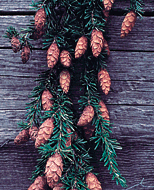
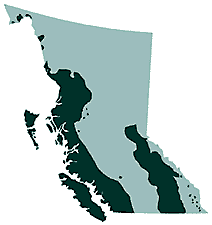 |
 |
A large tree that grows up to 60 m tall with a narrow crown, its leader distinctly drooping, with graceful, down-sweeping branches and delicate, feathery foliage. Its bark is rough and scaly, thick and furrowed in old trees and reddish brown in colour. The twigs are slender, roughened by the peg-like base where needles have fallen. The needles are short (less than 3.3 cm long), blunt and flat, green above and white underneath. It has small, numerous cones (about 2.5 cm) that are greenish and turn brown with age. Western hemlock is usually found in the coastal regions of the Pacific Northwest and grows from sea level to 2,250 m.
Photos and map from Tree Book Online
Information from 3 sources
BackMountain Hemlock
Tsuga mertensiana
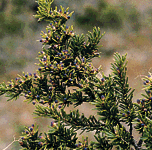 |
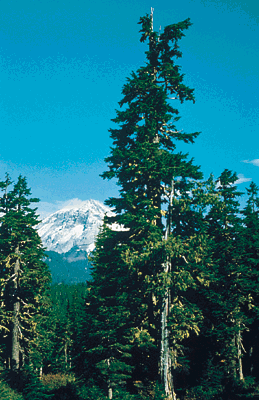 |

Mountain hemlock usually grows in subalpine areas and is up to 40 m tall. Needles are between 1 and 3 cm long and equal in length, blunt, bluish-green in colour and have a star-like appearance on short shoots. Seed cones are light to dark purple, 3-8 cm long and narrow at each end. The pollen cones are bluish. The bark is deeply furrowed and ridged, its colour dark reddish-brown. This type of hemlock grows on exposed ridges and slopes in the Pacific Northwest, and in the mountains of British Columbia and Idaho. Mountain hemlock is found at altitudes up to 3,300 m. In many places where mountain hemlock grows, the snow doesn't melt until July or August.
Photos from Tree Book Online and Trees of the Pacific Northwest, map from
Tree Book Online
Information from 3 sources
Back
| Index |
| True Fir |
| Spruce |
| Pine |
| Hemlock |
| False Cedar |
| Other Conifers |
| Bibliography |
False Cedars
Yellow Cedar (Chamaecyparis nootkatensis)Western Redcedar (Thuja plicata)
Jump to: Home|
Projects Page|
PRP Page
Western Redcedar
Thuja plicata
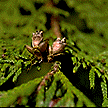 |
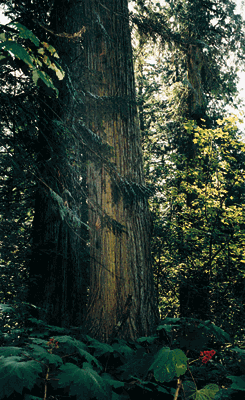 |
|
|
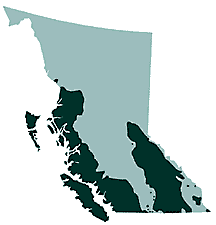 |
Western redcedars are mainly found in moist to wet soils, bogs, places with rich soils, seepage and alluvial sites. The branches tend to drop then turn upward, in a sideways J-shape. The bark is grey to reddish-brown, tears off in long strips, and aromatic. These trees are found in lower elevations, up to 1,800 m with a lot of precipitation.
A large tree growing up to 71 m tall with a diameter of 631 cm and 1,400 (maybe 2,000) years old at its maximum, although they are usually 40 to 50 m tall with a diameter of 150 to 300 cm and 1,000 years old. The Western Redcedar has scale-like leaves that are pressed to the twigs. The leaves are green above, have a white butterfly pattern below, and in four rows. In two rows they are folded and in the other two not folded, arranged overlapping shingle pattern. Pollen cones are reddish and numerous, while seed cones are egg-shaped with several pairs of scales, about 1 cm long, woody and turned upward. These are green when immature and turns brown over time, with winged seeds inside.
Photos from Tree Book Online and Trees of the Pacific Northwest, map from
Tree Book Online
Information from 3 sources
Back
Yellow-Cedar
Chamaecyparis nootkatensisAlso known as Alaska-cedar
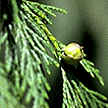 |
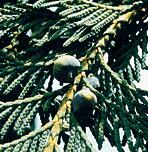 |
 |
 |
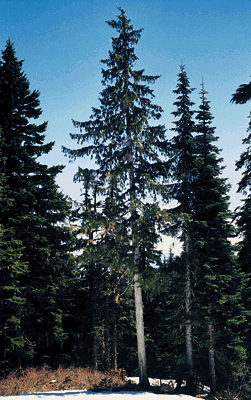 |
The yellow-cedar is very much like the Western redcedar, although the scale-like leaves don't have white patterns underneath and the four rows of leaves are all the same. The bark is dirty white to greyish-brown and rips off in shorter pieces. The trunk is often slightly twisted and flattened branches appear to hang vertically, appearing limp. The yellow-cedar is usually lives up to 1,000 years old, although its maximum is 1,824 (maybe 2,000) years, with a diameter of 100-150 (max. 365) cm and a height of 20 to 40 (max. 62) m.
The seed cones are small, round, and woody less than 1 cm in diameter. The pollen cones are about 4 mm long. The yellow-cedar ranges from southeastern Alaska to Oregon in cool, humid climates and are usually found at elevations of 650-2,500 m.
Photos from Tree Book Online and Trees of the Pacific Northwest, map from
Tree Book Online
Information from 3 sources
Back
| Index |
| True Fir |
| Spruce |
| Pine |
| Hemlock |
| False Cedar |
| Other Conifers |
| Bibliography |
Spruce
Englemann Spruce (Picea engelmannii)
Sitka Spruce (Picea sitchensis)
Jump to: Home| Projects Page| PRP Page
Engelmann Spruce
Picea engelmannii
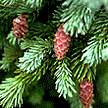 |
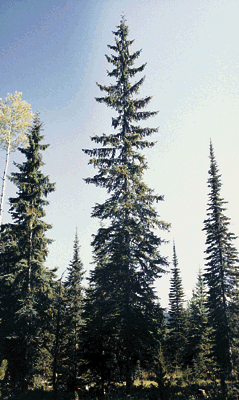 |
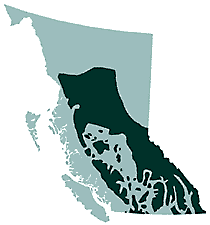
Engelmann spruce was named for George Engelmann (1809-1884), a German physician and botanist.
A straight tree with a spire-like crown, Engelmann spruce can reach 50 metres tall when mature. Its needles are four-sided, sharp, and bluish-green with two white bands on both the upper and lower surfaces. (Do not try to crush the needles, because they will stink). Seed cones are yellow to purplish-brown and hang from the upper branches. Their papery seed scales are tapered at both ends and have a ragged outer edge. Engelmann spruce grows at high elevation along the east slope of the Coast Range.
Photos from Tree Book Online and Trees of the Pacific Northwest, map from
Tree Book Online
Information from 2 sources
Back
Sitka Spruce
Picea sitchensis
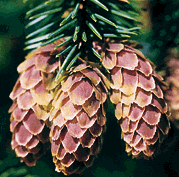 |
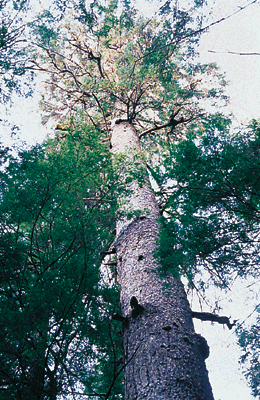 |
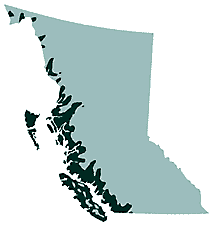
Sitka spruce is large tree that commonly grows up to 70 m tall and 2 m across when mature. The largest known tree of this species is 93 m tall and 5 m across. Its needles are light green to bluish-green, stiff, and sharp. The needles are arranged spirally along the twig and are attached by small pegs that remain on the twig after the needles fall. The seed cones are reddish-brown to yellowish-brown and hang from the crown. Sitka spruce grows along the coast in a narrow band from sea level to about 700 m elevation.